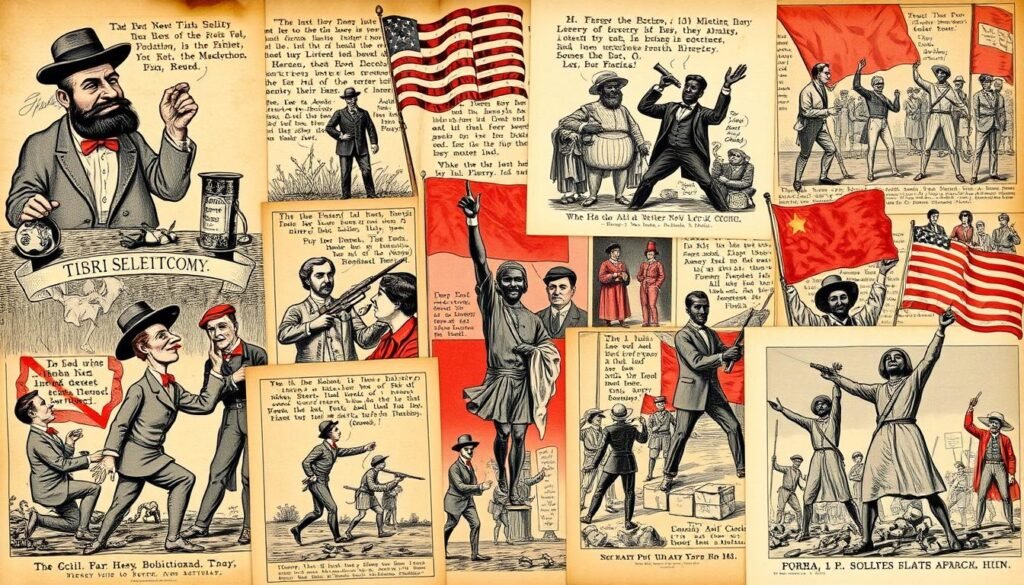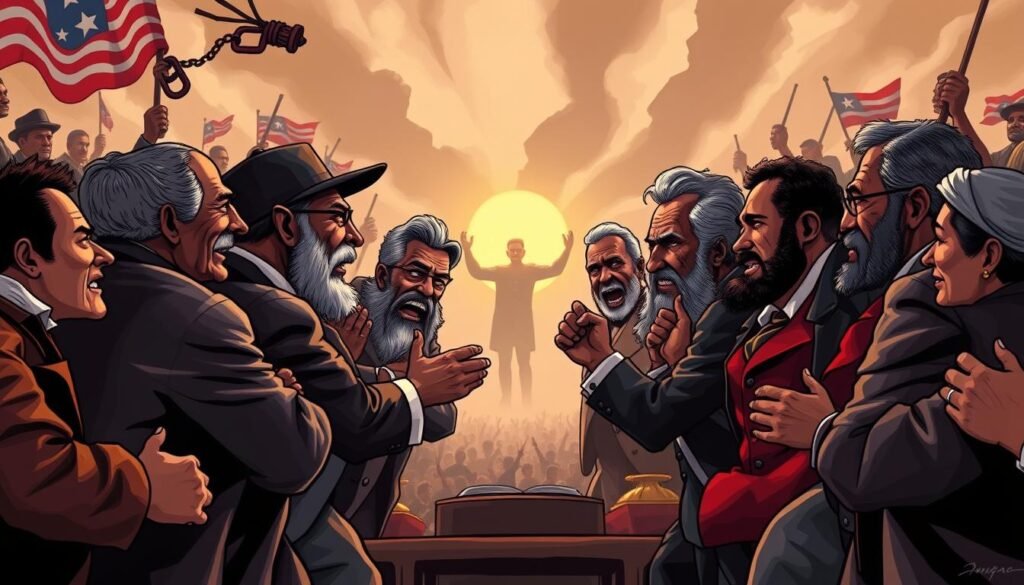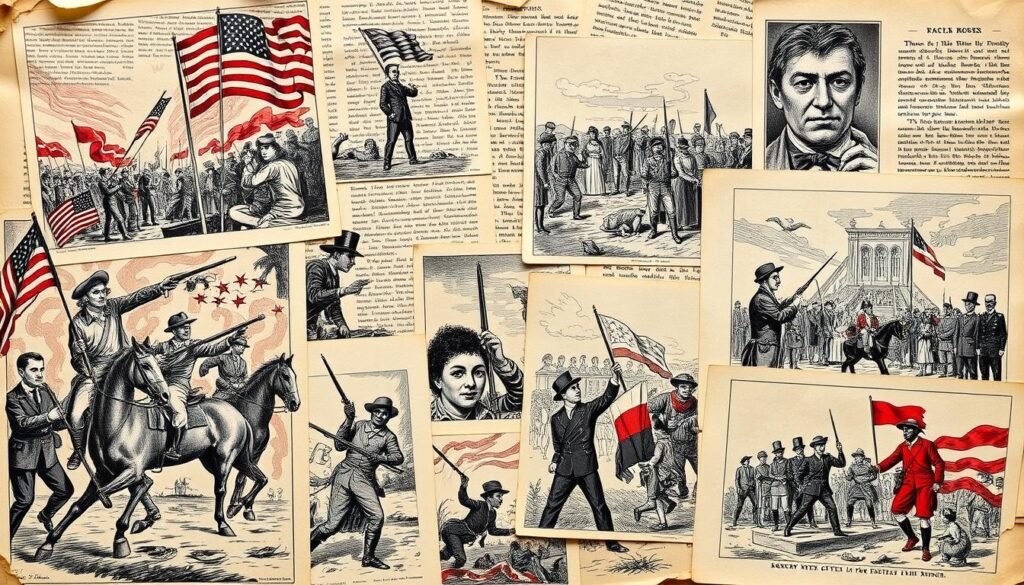The Role of Civil War Cartoons in Abolitionist Publications
Did you know that hundreds of thousands of readers were influenced by Harper’s Weekly? It was a key source of pictorial politics during the Civil War. Civil War political cartoons, like those by Thomas Nast, used wood engraving to send strong messages.
The steam press made it easy to print lots of cartoons quickly. This helped spread their impact on public opinion. Cartoons and literacy efforts went hand in hand, reaching even those who couldn’t read.
Key Takeaways
- Civil War political cartoons played a significant role in shaping public opinion during the Civil War era.
- The Role of Civil War Cartoons in Abolitionist Publications helped to convey powerful messages and influence perceptions of Abraham Lincoln.
- Thomas Nast’s wood engraving techniques were instrumental in creating impactful Civil War political cartoons.
- The steam press technology increased the reach and impact of Civil War political cartoons.
- The Role of Civil War Cartoons in Abolitionist Publications and Civil War political cartoons contributed to an increase in literacy efforts.
- Civil War political cartoons, such as “A Man Knows A Man” and “I’m Sorry I have to Drop You Sambo”, critiqued Lincoln’s Emancipation Proclamation and showcased divided opinions on his stance.
The Rise of Political Cartoons in Pre-Civil War America
In the early 1800s, political cartoons started to grow thanks to new printing tech. This led to the launch of Punch magazine, a key spot for political jokes. The word “cartoon” first appeared in Punch, starting a new chapter in political art.
The Impact of cartoons on abolitionist movements was huge. They were a strong way to comment on society and criticize it. Cartoons like “The Land of Liberty” showed the irony of American freedom in the 1840s. They pointed out the gap between the country’s ideals and how it treated slaves. Abolitionist propaganda used funny drawings and symbols to grab people’s attention and change their views.
Some famous cartoons from this time include:
- “The Plumb-Pudding in Danger” by James Gillray, a top political cartoon ever
- “The Coffin Handbills” series, which went after Andrew Jackson in 1828
- “A Minister Extraordinary Taking Passage”, about the 1832 murder trial of Ephraim Avery
Political cartoons kept getting better in the 1800s, with the Civil War era seeing more of them. During the war, cartoons played a big role in shaping what people thought and talked about.
| Cartoon Title | Artist | Year |
|---|---|---|
| The Plumb-Pudding in Danger | James Gillray | 1805 |
| The Coffin Handbills | Unknown | 1828 |
| A Minister Extraordinary Taking Passage | Unknown | 1832 |
Understanding The Role of Civil War Cartoons in Abolitionist Publications
The historical significance of Civil War cartoons is huge. They helped shape public opinion and change the war’s outcome. Cartoons were a mix of propaganda and satire. They let artists share their views on the war and its leaders.
Abraham Lincoln was often shown in cartoons. His nickname “The Railsplitter” made him more appealing to workingmen. Cartoons in abolitionist publications raised awareness about slavery and the war.
Some key examples of the historical significance of Civil War cartoons are:
- Thomas Nast’s cartoons, published in Harper’s Weekly, showed the struggles of African Americans during the war and Reconstruction.
- Cartoons were used to criticize politicians, like Andrew Johnson, who vetoed bills meant to limit Southern influence.
- Cartoons depicted the Ku Klux Klan and other violent groups. They warned about the dangers they posed to African Americans.
The historical significance of Civil War cartoons shows the power of art and satire. They shaped public opinion and influenced history. By looking at these cartoons, we learn more about the Civil War era’s complexities and challenges.
Major Abolitionist Publications and Their Cartoon Content
Abolitionist publications were key in shaping public views during the Civil War era. Civil War satire in abolitionist media was a strong tool to criticize slavery and push for abolition. The Liberator, for example, used cartoons and illustrations to share its message.
The Liberator’s Visual Strategy
The Liberator made its message clear to more people, thanks to its visuals. Abolitionist propaganda was also found in other papers, like Harper’s Weekly. This featured cartoons by famous artists, like Thomas Nast.
Harper’s Weekly Contributions
Harper’s Weekly was a big player in pictorial politics during the Civil War. Its cartoons often dealt with slavery and abolition. The use of Civil War satire in abolitionist media helped change public opinion and shape the war’s outcome.
Even lesser-known abolitionist papers made big contributions. They used Abolitionist propaganda to spread their message and gain support. These papers were vital in guiding the Civil War and ending slavery.
Artistic Techniques and Symbolism in Civil War Era Cartoons
Civil War cartoons were key in spreading the abolitionist message. They used techniques like caricature, satire, and symbolism. Caricature made famous faces look silly and easy to mock.
“Sinbad Lincoln and the Old Man of the Sea” is a great example. It showed the Navy’s struggles during the war. This symbolism made complex ideas simple and strong. Satire was common, targeting figures like Secretary Welles over corruption and naval issues.
These methods were vital in shaping public views and the war’s outcome. Cartoonists used simple yet powerful visuals to reach many people. This made Civil War cartoons a big part of the abolitionist fight.
Notable Cartoonists of the Abolitionist Movement
Cartoons played a big role in the fight against slavery. Many cartoonists, like Thomas Nast, were key players. Nast is famous for creating the modern Santa Claus image. But he also used his art to talk about big issues like slavery.
Cartoonists like Nast were vital in changing people’s minds. They used their art to show the wrongs of slavery. Nast’s Santa Claus pictures often had hidden messages about freedom.
Other important cartoonists included Frank Bellew and women like Anna Leonowens. They all used their art to speak out against injustice. Together, they helped make the abolitionist movement more visible.
| Cartoonist | Notable Works |
|---|---|
| Thomas Nast | Illustrations of Santa Claus, abolitionist propaganda |
| Frank Bellew | Abolitionist cartoons, illustrations for Harper’s Weekly |
| Anna Leonowens | Illustrations of social and political issues, abolitionist propaganda |
Their work is remembered today. It shows how cartoons helped fight slavery. It also highlights the power of art in changing minds.
Propaganda Techniques and Messaging Strategies
Civil War cartoons are important because they used satire and caricature to send strong messages. These cartoons were key in shaping public opinion and affecting the war’s outcome. Gary E. Wait said they brought relief and a break from confusion.
The Union had more resources and better printing, helping spread their messages. They focused a lot on abolitionism, which got support from Britain and France. Political cartoons were big, with 40% of American papers using them during the war.
Satire and caricature made complex ideas simple and easy to understand. The impact of Civil War cartoons on public opinion and the war’s outcome is clear. Today, studying these cartoons gives us insights into propaganda and messaging.
| Propaganda Technique | Description |
|---|---|
| Satire | The use of irony, sarcasm, and ridicule to convey a message |
| Caricature | The exaggeration of characteristics to create a humorous or critical effect |
Impact on Public Opinion and Political Discourse
Civil War cartoons had a big role in shaping public opinion and political talk during the Civil War. They showed the racism in society and the anger towards it, as Idris A. Young said. These cartoons gave us a peek into what people thought back then.
Some key points about these cartoons include:
- Northern people used them to rally against slavery and support the Union.
- Southern folks used them to defend slavery and the Confederacy.
- Cartoons also shaped how people around the world saw the Civil War and slavery.
As the war went on, cartoons changed to show new public views and political talks. They used emotive imagery and powerful symbolism. This helped get people on board with ending slavery. It played a big part in freeing 4 million slaves.
Visual Analysis of Key Anti-Slavery Cartoons
Abolitionist propaganda in cartoons was key in changing public views during the American Civil War. Cartoons like “Abe Lincoln’s Last Card” and “Freedom to the Slaves” showed how people felt about the Emancipation Proclamation. They highlighted the Impact of cartoons on abolitionist movements.
Many cartoons showed Union and Confederate forces in different ways. For example, “Gallant capture” shows both military officers and civilians, showing how actions affect people. The use of symbolic imagery, like the American flag with “All Men are Created Equal,” stressed equality in abolitionist views.
A great example of the Impact of cartoons on abolitionist movements is the cartoon about Jefferson Davis’s capture. It shows him dressed as a woman, showing the changing leadership in the Confederacy. These cartoons helped grow support for ending slavery, shaping the Civil War’s outcome.
| Cartoon Title | Description | Impact on Abolitionist Movement |
|---|---|---|
| Abe Lincoln’s Last Card | Reflects public reaction to Emancipation Proclamation | Increased support for abolitionist movement |
| Freedom to the Slaves | Highlights the importance of freedom for slaves | Contributed to growing public support for abolition |
| Gallant capture | Critiques military actions under Confiscation Act of 1861 | Emphasized absurdity of appropriating civilian goods for military expenses |
The Legacy of Abolitionist Political Art
Civil War cartoons are important because they share strong messages and shape opinions. They used satire to show the wrongs of slavery and push for its end.
Gary E. Wait says satire and caricature in these cartoons gave people a break. They showed the power of these cartoons in shaping today’s political cartoons. Many cartoonists today look up to Thomas Nast and other abolitionist artists.
Modern Political Cartooning
Today, political cartoons are key in shaping public views and political talks. Satire and caricature are powerful for commenting on society. Cartoonists now tackle issues like racism, inequality, and justice.
Civil Rights Movement Connections
The impact of abolitionist art is also seen in the Civil Rights Movement. Cartoonists used satire and caricature to fight for racial equality and justice. This shows a link between the past and present in political art.
| Statistic | Description |
|---|---|
| Thomas Nast’s production rate | 5-6 cartoons per week during his campaign against Boss Tweed |
| Boss Tweed’s wealth | Approximately $45 million, equivalent to nearly $1 billion today |
| Harvard affiliates in the Cambridge Anti-Slavery Society | 48% of the original 23 members |
These facts show how big an impact abolitionist cartoons had on America. They highlight why we should keep and study these historical pieces.
Preservation and Digital Archives of Civil War Cartoons
Keeping Civil War political cartoons safe is key to understanding their impact. Places like the Library of Congress have big collections. They include works by famous cartoonists like Thomas Nast and Louis Maurer.
These collections are not just important for history. They also show how cartoons helped fight for ending slavery and keeping the Union together. By saving these cartoons, we learn more about their role in history.
Thanks to digital archives, more people can see these cartoons. This helps everyone understand their importance. Civil War political cartoons offer a special view of those times.
Important parts of keeping these cartoons safe include:
- Keeping the original cartoons and prints safe
- Scanning and archiving them digitally
- Making them available online for research and learning
By saving and sharing these cartoons, we make sure their value is remembered. They give us important insights into the Role of Civil War Cartoons in Abolitionist Publications.
Conclusion: The Lasting Influence of Civil War Era Political Cartoons
The political cartoons of the Civil War era have made a lasting impact on America. They showed the anger and racism of the abolitionist movement. Idris A. Young notes these cartoons reveal the deep prejudices of the time.
These cartoons played a big role in shaping public opinion during the Civil War. They were key in criticizing the Second Bank of the United States and the sinking of the Lusitania. The Abolitionist movement used them to gain support for their cause.
Looking back, we see how these cartoons continue to shape our view of history. They show us the tumultuous times that formed our nation. Their lasting impact proves the power of art in shaping politics and inspiring change.
FAQ
What was the role of Civil War cartoons in abolitionist publications?
How did the rise of political cartoons in pre-Civil War America contribute to the abolitionist movement?
What was the historical significance of Civil War cartoons in abolitionist publications?
What were the major abolitionist publications that featured cartoon content, and how did they contribute to the movement?
What artistic techniques and symbolism were used in Civil War era cartoons to convey the message of the abolitionist movement?
Who were the notable cartoonists of the abolitionist movement, and how did their contributions shape the outcome of the Civil War?
What propaganda techniques and messaging strategies were used in Civil War cartoons to support the abolitionist cause?
How did Civil War cartoons impact public opinion and political discourse in the North, South, and internationally?
What key anti-slavery cartoons from the era provide insight into the visual messaging of the abolitionist movement?
How has the legacy of abolitionist political art influenced modern political cartooning and civil rights movements?
How are Civil War cartoons being preserved and digitized for future generations?
Source Links
- Microsoft Word – 177_Idris Young
- How Abraham Lincoln Was Portrayed in Political Cartoons | HISTORY
- National Cartoonists Day: An Iconic Civil War Cartoon from Milestone Visual Documents in American History – Schlager Group Inc
- Political Cartoons, Part 2: 1800-1850 – First Amendment Museum
- The election of 1864 as seen through the Harry T. Peters “America on Stone” Collection
- Teaching the Civil War through Political Cartoons
- Thomas Nast’s Political Cartoons | American Experience | PBS
- African Americana Political Cartoons | Library Company of Philadelphia Digital Collections
- The Legacy and Impact of Political Cartoons on National Identity
- Cartoon Wait
- Political Cartoons Analysis: A Brief History – Superside
- Thomas Nast – Illustration History
- A Civil War Cartoonist Created the Modern Image of Santa Claus as Union Propaganda
- Thomas Nast
- american civil war propaganda
- american civil war propaganda
- Civil War Primary Sources | Databases & Collections | Gale
- Out of War, a New Nation
- Stowe’s Global Impact
- Civil War Political Cartoons | Library Company of Philadelphia Digital Collections
- Images | The Abolition Seminar
- The Political Cartoonist Who Helped Lead to ‘Boss’ Tweed’s Downfall | HISTORY
- Smarthistory – Nast and Reconstruction: understanding a political cartoon
- Intellectual Leadership: Harvard, Slavery, and Its Legacies before and after the Civil War | Radcliffe Institute for Advanced Study at Harvard University
- Research Guides: American history: U.S. Civil War
- Manhood in Civil War Cartoons
- African Americana Political Cartoons | Library Company of Philadelphia Digital Collections
- The Political Cartoon That Explains the Battle Over Reconstruction
- The Comic News, Lincoln, and the Civil War
- Political Cartoons and Public Debates | Classroom Materials at the Library of Congress | Library of Congress
























